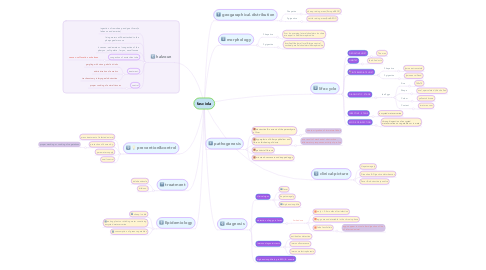
1. halzoun
1.1. ingestion of raw sheep and goat livers(in lebanon and america)
1.2. living worms will be attached to the pharyngeal mucosa
1.3. it causes : oedematous / congestion of the pharynx , soft palate , larynx , nasal fossae
1.4. congestion of eustachian tube
1.4.1. causes: suffocation as halzoun
1.5. treatment:
1.5.1. gargling with strong alcolic drinks
1.5.2. administration of emetics
1.5.3. tracheostomy in laryngeal obstruction
1.6. control
1.6.1. proper cooking of animal tissues
2. Epidemiology
2.1. sheep / cattle
2.2. eating plants or drinking water conatining encysted metacercariae
2.3. consumption of green vegetables
3. prevention&control
3.1. mass treatment of infected animal
3.2. protection of human by:
3.2.1. proper washing or cooking of vegetations
3.3. pure water supply
3.4. snail control
4. treatment
4.1. triclabendazole
4.2. bithionol
5. diagnosis
5.1. clinical signs
5.1.1. fever
5.1.2. hepatomegaly
5.1.3. high eosinophilia
5.2. detection of eggs in feces
5.2.1. limited use
5.2.1.1. only + 3-4 months after infection
5.2.1.2. eggs are undetectable in the chronic phase
5.2.1.3. false fasciloliais
5.2.1.3.1. eggs appear in stool after digestion of liver of infected animal
5.3. immunodiagnostic tests
5.3.1. antibodies detection
5.3.2. immunofluorecence
5.3.3. immuno-electrophoresis
5.4. high eosinophilia (up to 80%) & anemia
6. clinical-picture
6.1. Hepatomegaly
6.2. Diaerrhea & Digestive disturbances
6.3. Fever & obstructive jaundice
7. pathogenesis
7.1. destruction & necrosis of the parenchyma of liver
7.1.1. due to migration of immature flukes
7.2. hyperplasia of biliary epithelium and fibrous thickening of ducts
7.2.1. as a result of mechanical obstruction , inflammatory responses,activity of proline
7.3. periductal fibrosis
7.4. minute absesses around trapped eggs
8. life-cycle
8.1. DEFINITIVE HOST
8.1.1. The man
8.2. HABITAT
8.2.1. the bile ducts
8.3. INTERMEDIATE HOST
8.3.1. F.hepatica
8.3.1.1. lymnaea truncatula
8.3.2. F.gigantica
8.3.2.1. lymnaea cailliaud
8.4. DIAGNOSTIC . STAGE
8.4.1. the Eggs
8.4.1.1. Size
8.4.1.1.1. 140x70
8.4.1.2. Shape
8.4.1.2.1. oval,operculated ,thin shelled
8.4.1.3. Colour
8.4.1.3.1. yellowish brown
8.4.1.4. Content
8.4.1.4.1. imature ovum
8.5. INFECTIVE . STAGE
8.5.1. encysted metacercariae
8.6. MODE.OF.INFECTION
8.6.1. through ingestion of encysted metacercariae on vegetables or in water
9. morphology
9.1. F.hepatica
9.1.1. 3cm /converging lateral shoulders /suckers are equal in size/hermaphrodite
9.2. F.gigantica
9.2.1. 6cm/leaf-like/small oral &large ventral suckers/parallel shoulders/hemaphrodite
10. geogaraphical.distribution
10.1. F.hepatica
10.1.1. sheep raising areas (Europe&EGY)
10.2. F.gigantica
10.2.1. cattle raising areas(Asia&EGY)
